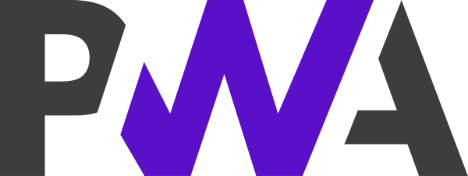
The introduction of smartphones in the early millennium revolutionized the whole tech world. We witnessed a sudden drift of the user base from desktops and laptops to more compact and palm-sized gadgets where they could do the same day-to-day activities at the touch of their finger from their couch. The portability, compact size, and ease of use demanded the developers to build mobile apps catering to a plethora of requirements.
Although mobile apps bring a whole new level of experience, developing a mobile application requires highly skilled resources, a steep learning curve, development time, and cost to develop and maintain the seamlessness of the application. Moreover, these mobile applications are platform-dependent. Each new feature needs to be developed by respective teams and deployed on all platforms like iOS, Android, Ubuntu, Windows etc. to maintain the same user experience. In short, building and maintaining an application drains a lot of resources in terms of cost, manpower, and energy. These challenges require a robust solution. And the answer is PWA. Let’s understand more about PWAs in the next sections.
INTRODUCTION
PWA aka Progressive Web Application is a modern outlook of a traditional web application that can be accessed by any conventional URL, yet it looks, feels and works more like a mobile application. To simplify the concept further, in progressive web design developers put together the best attributes of modern web applications and endow them with native application experience. In this paradigm, you progressively enhance your existing web pages to feel and work more like native mobile apps. It means if you have a modern browser on a mobile device, you get an awesome experience, otherwise you get the experience you've gotten anyways.
Desktop and Mobile Experience
Chromium-based browsers allow installation of PWA in local machines. It creates a shortcut to the application on the desktop or in the taskbar or in the dock depending on the OS installed.
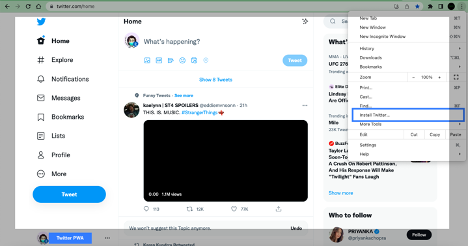
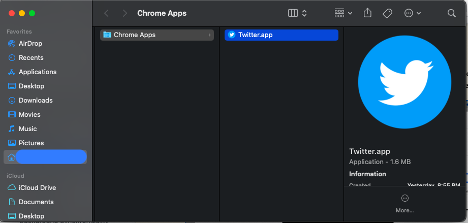
Similarly, Safari on iOS also supports installing PWAs to the home screen. The user taps the share button and selects Add to Home Screen. These applications behave more like a native app, sends push notifications, open even without a network, can access the hardware like camera or geolocation as well, and are quite lightweight. The user need not have to go to the App Store to install the heavy bulky application whereas the PWA version can serve most of the purposes.
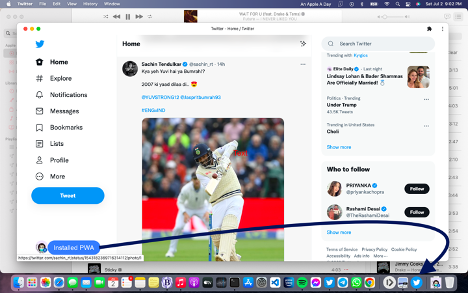
A progressive web app now combines the best of both worlds, provides access to a lot of the native device features, can be made available offline, and maintains excellent reach since it's still a web app running in the browser.
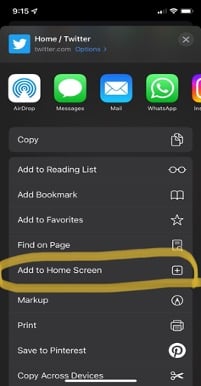
Salient Features of PWA
These feature-rich progressive web applications are the future of current web applications with rich user experience. Especially for small firms or startups, progressive web apps save a lot of cost and resources, yet the product they publish is no lesser standard than the native apps. Here are some of the worth mentioning features that put PWA on the front seat.
- Works Offline
Unlike most native apps or websites which show 404 error user interfaces or stop rendering, the progressive web apps show some basic content to the user. This gives a unique user experience and keeps them engaged. The best example we can give here is WhatsApp messaging service. If you ever try to open WhatsApp with no network connectivity, you still can see the existing messages, can see display pictures, change settings etc. Once you are connected to the internet, the dynamic contents change, and you get new messages and the latest display picture. - Fast Loading
Progressing web applications loads faster in comparison to the traditional counterpart. It attains this by intelligently caching and diligently using the web storage. If you have visited the application once, the subsequent loads take very little time. Instant loading prevents the user from distraction and wait time. - Background Synchronization
Imagine your native application rolled out a UPI integration feature recently. To use this new feature the application needs to be updated from the app store or play store. No updates or reinstalls are needed in case of PWAs. Progressive web applications are simple web applications. If the application introduces a new feature, one can seamlessly access it by revisiting the URL - Platform Independent
A native application is platform specific. An Android version of the application cannot be installed on iOS. So, the same application needs different builds for different platforms. Progressive web applications overcome this drawback by providing true platform-independent solutions. One can create a shortcut of the web application on the home screen, and it opens on a web platform yet behaves more like a native application. No more effort to put into development for different platforms, thereby saving dollars on resources. - Push Notification
Whenever an application receives an update, it notifies the user beforehand by providing a headline on push notifications. One can see it in the notification center. This useful feature is no longer limited to native applications. Your web application can now send push notifications of important updates and one can read them before even opening the application. - SEO Friendly
A progressive web application is search discoverable. The sites can be indexed in search engines. So, promoting such applications is easier than the native apps where one needs to pay heftily to third-party advertising agencies for campaigns. - Security and Safeguard
PWA enforces transport layer security. The website of the PWA provides secure HTTPS, so installing an SSL certificate on the server is a must. In the case of the native apps where multiple apps can have the same name which adds to the confusion, a PWA’s URL matches its site’s domain name. So, by installing the PWA to Home Screen, the user knows that they’re installing the right app. Such applications do not talk to native hardware without the owner’s permission, thus reducing security breaches and malicious code in the background. - Native Experience
A PWA is home-screen friendly which means that PWAs make our application installable and can be pinned to home screens or Start Menu just like native apps (but not installed through the app store). Just like a native app can be opened with a single tap of your fingertip, the same can be achieved using a PWA once it is installed on the home screen. It is adaptable to any device of any screen size, any resolution, or any orientation and browser, thanks to its responsiveness.
Technologies Behind PWA
- Service Worker
Service Workers are the soul of progressive web apps. Service workers run in the background in an independent thread and handle requests that do not need user attention. Service workers typically bring two significant features on board, viz, offline mode and background sync. Let’s understand how this can be achieved.
When there is a request made from the application, the service workers hijack the request and act as a proxy to the network connection. If an active network connection can be established, then the service workers fetch the data from the server. In case of a flaky connection or even offline mode, service workers serve the request through cache through the Cache Storage API. Thus, it ensures the user has at least some interactivity with the app rather than viewing a crashed user interface. Of course, with a limited connection, the user has limited experience with the application.
Once the network connection is restored, the same service workers fetch the data and serve the application, thereby addressing the background synchronization feature. Basically, in an offline mode, if a request is made, then the service workers take care of it and complete it once the network is available.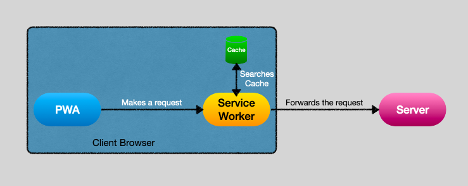
Demo implementation of Service Worker.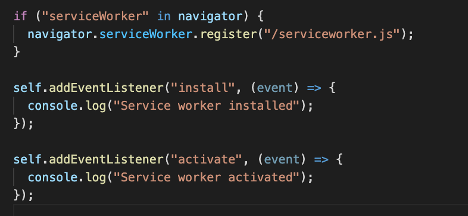
Service-workers also provide some more worth mentioning features like push notifications even when the app is not active, caching network requests, caching static contents, background code execution, payment processing, etc. - Caching Storage API
Cache storage is such a powerful tool that it makes the application less dependent on the network state. Service workers interact with the Cache Storage API to cache some resources and assets for offline activity. Only those resources are meant for caching which needs frequent visits. Mostly these resources include the main web page, CSS stylesheets, images, web fonts, configurational JSON files, etc. Once the application is visited for the first time, these resources are cached. Service workers manage the updates and deletion of any cached resource on the server to sync the cache with the server.
Demo implementation of the cache storage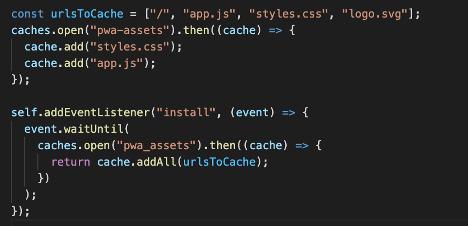
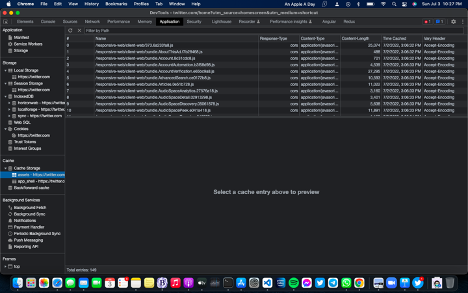
- Web App Manifest
The web app manifest is a JSON file that sets the look and feel and basic behavior in the operating system. This configuration file makes the web app installable. For PWA, the web app manifest file is the starting point for all user interactions, and all the metadata about how we display the application to the user is included here. Using this JSON file, we can easily change many elements of the application, including app icons, theme colors, orientation, and splash screen.
<html lang="en">
<link rel="manifest" href="/manifest.json">
—----------------------------------------------------------
<link rel="manifest" href="/app.webmanifest" crossorigin="use-credentials">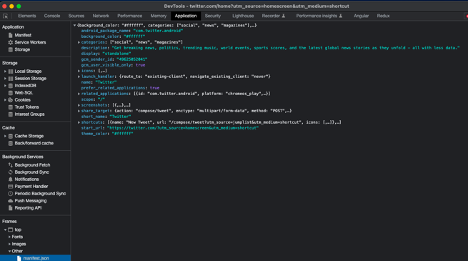
Final Thoughts
In summary, the PWA is a term that refers to additional features you can add to any web application running in the browser, therefore enhancing your existing web pages to get a more real-time experience of native mobile apps. Organizations like Twitter, Instagram, MakeMyTrip, Pinterest or Uber, have already progressed towards PWA design to reach out to larger audiences. The success of these PWAs opens a window for many to adopt this approach. We can also perform a lighthouse audit (a built-in tool in Google Chrome) on any site to understand how well the site performs as a PWA. From a developer’s point of view, it is easier to develop a PWA in relatively less time than developing a native application. The native look and feel, smaller size, high throughput, scalability, and robustness make such applications popular among users. From the marketing point of view, if it is cost-effective and can bring a good user base, it can be profitable.
About Encora
Fast-growing tech companies partner with Encora to outsource product development and drive growth. Contact us to learn more about our software engineering capabilities.